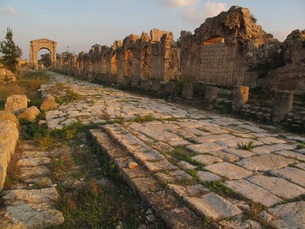- Visit Lebanon

- South Lebanon

- Tyre (Sour)
Tyre (Sour)

Located about 80 kilometers (1.5 hour drive) from Beirut and 40 kilometers from Saida, the old and pleasant port city of Tyre used to be a flourishing international trade center and has a rich history. Although nowadays it is one of the least economically developed cities of Lebanon, few yet important traces of its golden past remain.
The history of Tyre goes back about 5,000 years, starting with Egyptian influence in the 14th century BC, yet the actual power and wealth of the city commenced in the 10th century BC under the rule of King Hiram I. His close connection with King Solomon and David helped develop trade of cedar wood, gold and other luxury goods to Jerusalem, Arabia and Africa. As in Saida, the purple dye extracted from murex (molluscs) brought the city great prosperity. After the Babylonian King Nebuchadnezzar besieged Tyre in 586 BC, it was conquered by the Persians (539 BC), followed by the Greeks (332 BC), who only gained power after a huge battle, massacre and destruction of half the city, followed by putting into slavery many citizens. The Romans (64 BC) brought the city peace and prosperity, while the Byzantines (395) and Arabs (634) introduced Christianity, respectively Islam to the area. The Crusaders (1124) and Mamluks (1291) that followed severely damaged the city, after which Tyre became part of the Ottoman Empire in the 16th century. Following World War I, Tyre fell under the French Mandate. Predominantly Shi’ite, the town suffered from the Hezbollah - Israel conflict and the large Palestinian presence during the country’s Civil War (1975 - 1990). UNIFIL peace troops continue to be deployed in the area. In 1984, Tyre became a UNESCO World Heritage Site of Roman architecture and the city is now slowly regaining its charm.
The two Roman and Byzantine archaeological sites, the colorful Christian area, the pleasant fishing harbor and the laid-back green Corniche area are good reasons for visiting the city at least for a day. For beach lovers, the public beach in the Tyre Coastal Nature Reserve should definitely be included.
